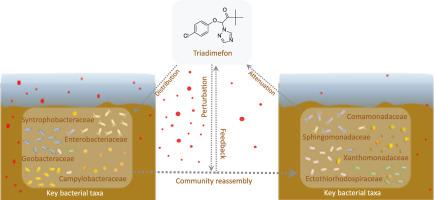Journal of Hazardous Materials ( IF 13.6 ) Pub Date : 2021-05-09 , DOI: 10.1016/j.jhazmat.2021.126061 Xiaoyan Fan 1 , Yan Fu 2 , Yanxia Nie 3 , Haruna Matsumoto 1 , Yue Wang 1 , Tingting Hu 1 , Qianqian Pan 1 , Tianxing Lv 1 , Hongda Fang 1 , Haorong Xu 1 , Yi Wang 4 , Hang Ge 5 , Guonian Zhu 1 , Yihua Liu 6 , Qiangwei Wang 1 , Mengcen Wang 7

|
The increasing input of fungicides has emerged as a global concern for agroecosystem stability and sustainability. Agroecosystem resilience has been linked to microbiome response, however, is not well understood. Focusing on a widespread triazole-class fungicide triadimefon in the paddy ecosystem, we characterized that the soils and sediments were dominant triadimefon reservoirs with the peak level at 195 μg kg−1 and 31.3 μg kg−1, respectively, but essential for the resilience of paddy ecosystem to triadimefon. In paddy simulation models, the half-life of triadimefon in soil-sediment was 8.4–28.9 days, while it was prolonged to 86.6–115.5 days after elimination of resident microbial community. Phospholipid fatty acid profiling and high-throughput sequencing showed that the distinctive bacterial community responses contributed to variable degradation of triadimefon in paddy soils and sediments. Sphingomonas and Xanthomonas were identified as positive responders of the keystone taxa in the responsive bacteriome, whereas Enterobacter were negative responders that declined over time. Synthetic assemblages combined with quantitative polymerase chain reaction further validated that Sphingomonas and Xanthomonas were involved in sustaining soil-sediment resilience to triadimefon contamination. Collectively, our results revealed that the shaping of soil and sediment bacteriomes was responsible for the resilience of the paddy agroecosystem to fungicide contamination.
中文翻译:

梯形分类群介导的细菌组反应塑造了稻田生态系统对杀真菌剂三唑酮污染的复原力
越来越多的杀真菌剂投入已成为对农业生态系统稳定性和可持续性的全球关注。农业生态系统的复原力已经与微生物组反应联系在一起,但是,人们对此知之甚少。着眼于稻田生态系统中广泛分布的三唑类杀菌剂三唑酮,我们的特征是土壤和沉积物是三唑酮的主要储集层,峰值水平为195μgkg -1和31.3μgkg -1,但对于稻田生态系统对三唑酮的复原力至关重要。在稻田模拟模型中,三唑酮在土壤沉积物中的半衰期为8.4–28.9天,而在消除居民微生物群落后,其半衰期延长至86.6–115.5天。磷脂脂肪酸谱分析和高通量测序表明,独特的细菌群落反应促成了稻田土壤和沉积物中三唑酮的可变降解。鞘氨醇单胞菌和黄单胞菌被鉴定为响应性细菌组中梯形分类群的阳性反应者,而肠杆菌则是随着时间而下降的阴性反应者。合成组合与定量聚合酶链反应相结合,进一步验证了鞘氨醇单胞菌和黄单胞菌参与维持土壤沉积物抗三唑酮污染的能力。总体而言,我们的结果表明,土壤和沉积物细菌的形成是稻谷农业生态系统对杀真菌剂污染的复原力的原因。



























 京公网安备 11010802027423号
京公网安备 11010802027423号